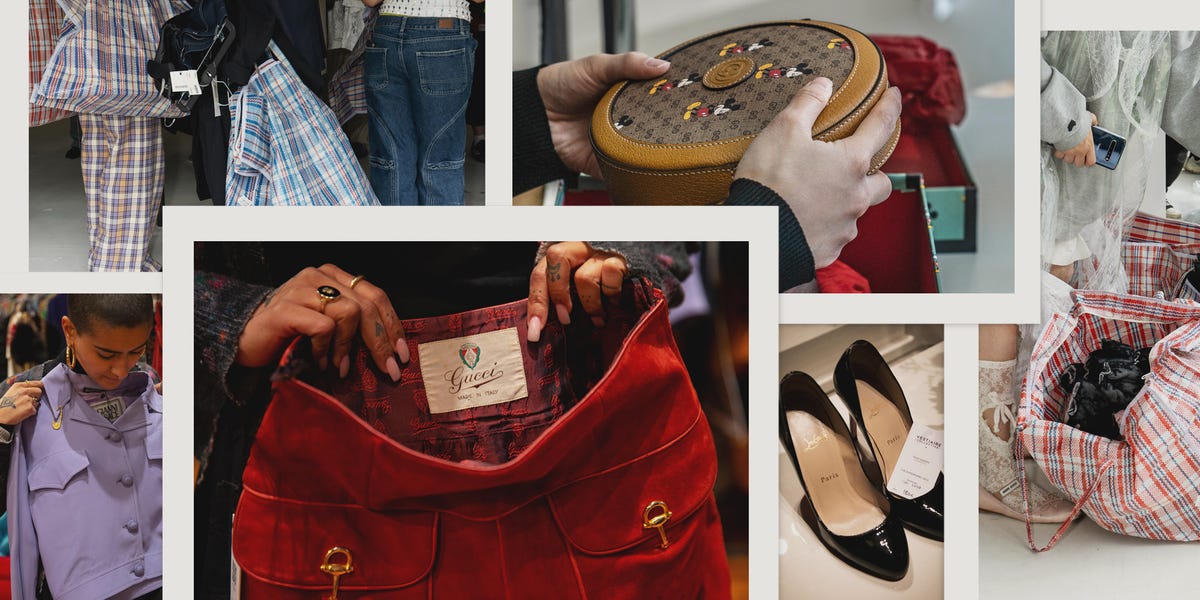Style Points is a column about how fashion intersects with the wider world.
“Last Days to Save. Shop Tariff-Free,” read the header on one high-end resale site last week. It was a sign that even the secondhand market—projected to become a $40 billion juggernaut by 2029—is set to be buffered by the proposed tariffs that are causing chaos and uncertainty in the economy right now. And while most coverage has focused on brand-new fashion, resale aficionados have been wondering: Will more shoppers turn to secondhand goods? Or are the resale and new fashion markets inextricably linked?
Initially, this moment might seem like a boon to resale, with shoppers turning to vintage or secondhand clothing out of frugality. And according to Axios, there’s historical precedent: secondhand shopping saw an uptick both during the Great Depression and the 2008 economic downturn. But Professor Shawn Grain Carter, Associate Professor of Fashion Business Management at FIT, doesn’t think the tradeoff is quite that simple. She raises the possibility that with fewer people shopping and reselling, and more holding onto clothing they might have otherwise flipped, bigger resale sites are “not going to be able to get the supply that they need to keep everything fresh.”
Instead, we might be looking at an overall slowdown, something she thinks fashion, with its focus on instant gratification, is sorely in need of. “We need circularity, but we also need to really think about, What does the purchase mean to you in terms of the psychology of the consumer? We have to get back to wanting things, but also realizing that you don’t have to have everything right away,” she says, adding that she reminds her students that it’s not normal to expect purchases to arrive in 24 hours. “There is fun in buying something that you really treasure that you can enjoy, and maybe you pass it down. Not everything has to be: ‘We must have it immediately.’”
Erika Veurink grew up in Iowa, where she first fell in love with thrifting. Now, she’s made a career out of it, in a way: her Substack newsletter, Long Live, focuses largely on secondhand fashion. Veurink has not seen much tariff talk in her Substack chat or comments thus far, “but I also have a lot of Midwestern readers who are primarily drawn to recession-proof brands like J.Crew, Land’s End, and L.L. Bean.” When it comes to the potential disruption of tariffs, Veurink has a sunnier take, saying, “I imagine a world in which this inspires people to visit their local thrift store. Not their hyper-curated secondhand vintage market, but a Savers, a Goodwill, a Salvation Army. Everyone in the culture at large has embraced thrifting as a concept, but a lot of times at a distance. Maybe this necessity of, ‘I want the feeling of acquiring new-to-me objects. I want to feel inspired by clothes. Maybe I’ll grab a friend and go to Salvation Army,’ would be the best-case scenario.”
The news happens to coincide with the already-brewing underconsumption movement and a renewed focus on investment dressing. Veurink says of her readers, “They’re a very discerning bunch and probably would say they’re looking to slow their roll. Nothing dramatic, like, ‘I’m no longer shopping,’ or, ‘I’m going on a shopping ban.’ But maybe this is coinciding with feelings they’ve already been having around consumption and personal style. Maybe this gives them a little more space to be like, ‘What actually works for me? What am I super passionate about acquiring?’”
It may also accelerate another trend: the rise of social, IRL shopping. Through her Gen Z students, Carter has seen that “people need community in person. They need to be around other people. Gen Z is the first generation to grow up never having been mall rats. They like this idea of going to shop in a physical store, even if it’s a pop-up. They are embracing it.”
And even if you can’t make it to a pop-up, Veurink notes that “the thing that’s so lovely about the itch to secondhand shop is that you can scale it up or down. If it’s a Saturday morning and you go on eBay, you could look for a vintage T-shirt under $15—and get the high that way.”




